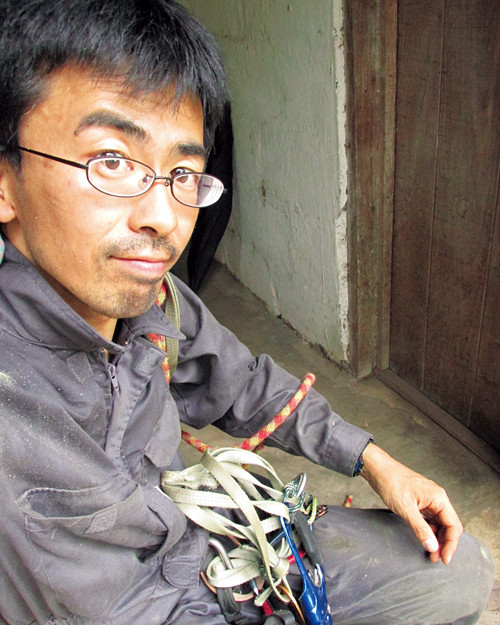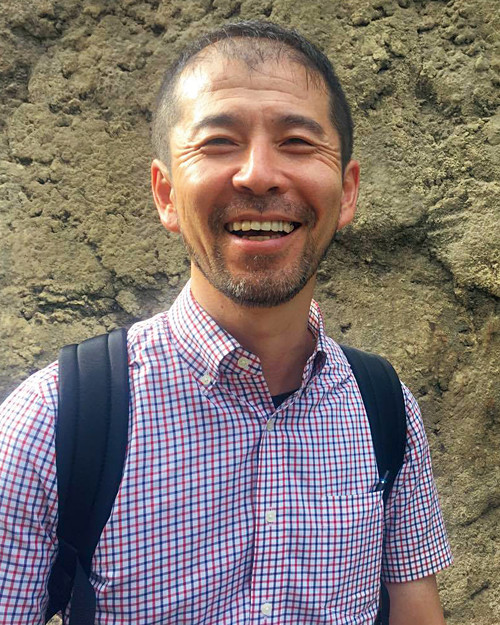Is sleep an instinct? Or is it culture?
We asked primate researcher Koichiro Zamma to join Shinichi Ishikawa and Megumi Kaji in discussing what constitutes blissful sleep for us hominids̶from the perspectives of the sleep of chimpanzees and the diversity of sleep encountered in Exhibition of Sleep: Evolution and Diversity of Material Cultures for Sleep. Ishikawa handled the design and planning of the Exhibition of Sleep. Kaji, of the Research Association of Sleep and Society, was also involved in planning and putting on the exhibition.
Koichiro ZAMMA

Center for African Area Studies, Kyoto University. Born 1972, Gifu. Specializes in anthropology and primatology. Current research involves sleep and nocturnal behavior of wild chimpanzees.Publications include a book in Japanese Chimpanzees make beds everyday: human evolution of sleep.
Shinichi ISHIK AWA

Designer, To-nan-sei-hoku Design Associates. Born 1969, Osaka. Worked at GK Kyoto before launching his own company. Lectures at the Kyoto University of Art and Design and Osaka Institute of Technology. 2014 SDA Award nominee for work on INAX Tile Museum.
Megumi KAJI

Joined pillow specialist Lofty in 1989. Worked on surveys and research involving sleep and society, becoming one of the initial employees of Loftyʼs Research Institute on Sleep and Society. In 2009, went independent, planning and organizing research into sleep and society. In 2010, took responsibility for the secretariat of the Research Association of Sleep and Society. Writings related to sleep, sleepwear, and times and places for sleeping include a book Gussuri (“Sleeping Soundly,” pub. Shinchosha), written from the perspective of a sleep enhancement instructor.

In spring 2016, the two MUJI stores in Kyoto showed exhibits on the theme of sleep, and Kyoto University Museum hosted the Sleep Exhibition. The organizing committee included Zamma, Ishikawa and the Research Association of Sleep and Society (Kaji runs its secretariat). Until recently, researchers tended to interpret sleep in scientific terms, but this project took a diversity of perspectives including cultural anthropology, sociology, and primatology, and was acclaimed for the way it compelled visitors to abandon their preconceptions about sleep. We ask our three guests to discuss the nature of sleep.
—Mr. Zamma, you study the sleep of our closest relatives, wild chimpa nzees. I've heard that chimpanzees have somewhat surprising sleeping habits.
ZammaWild chimpanzees make a new bed every night, high up in trees. They'll bend over dozens of branches to form an oblong bed frame of about 90 x 70 cm on which they then spread springy twigs and leaves. The bed is shaped like a shallow dish, with the edges higher than the center. These are, by the way, single beds. e lowest are maybe about 5 m from the ground, the highest over 20 m. That's equivalent to anything from the second to the sixth floor of a building.
—That high? Wow! Youʼve also slept in them, havenʼt you?
ZammaYes, and chimpanzee beds are amazingly comfortable. In fact, they're the most comfortable beds I've ever slept in! Itʼs difficult to put in words, but theyʼre neither too hard nor too soft. Being made of living branches, they're really pliant, and the thick layer of leaves spread over the branches makes the bed even cozier. Because they dip in the middle, you feel very secure in their embrace, and they sway nicely when you turn over. They kind of hug you, and you really do feel safe. Other large primates like gorillas and orangutans also make beds, but Japanese macaques and other monkeys don't share the habit.
—It seems to make sense that the only primates making such high-performance beds are the large primates credited with the highest intelligence.
Zamma Actually, some say itʼs the other way around̶ theyʼve evolved to such a high level precisely because theyʼve always slept so well. Getting the right balance between REM sleep and non-REM sleep is thought to be important for developing intelligence, and during REM sleep, trunk muscles tend to relax and your whole body loosens. Monkeys that sleep sitting on branches canʼt relax, but chimpanzees and other large primates get to sleep in these amazingly comfortable beds theyʼve made at the tips of branches out of reach of any enemies. The theory is that large primates evolved into such intelligent creatures because their beds gave them a good balance of REM and non-REM sleep.
—So itʼs sleep that drove the evolution of chimpanzees? Thatʼs a fascinating take.
Ishikawa I think humans are the same. Did you ever notice how you're so clearheaded during the time between waking up and eating breakfast that you can do anything easily? Iʼve also noticed that people around me who are at the cutting edge of their particular fields are open-minded about napping. And I also think theyʼve always slept well.


They've just never admitted to doing so. I think they probably knew intuitively that taking a siesta is good for you. Shigehiko Toyama talks about how good ideas come to you when youʼre totally absorbed in something, or when you're walking or taking a bath, and when youʼre on the toilet, on a horse, or when your head is on a pillow, which suggests to me that thereʼs a close connection between sleep and development or evolution of the brain.
KajiThere definitely is a close relationship between sleep and brain performance. By the way, I've heard that chimpanzees also nap during the day.
ZammaYes, sometimes they make a bed to take a nap, but they also sleep hanging onto a branch, just like a tired company employee strap-hanging in a rush-hour train.
IshikawaA lot of researchers are sure enough of themselves that they just go off and sleep without a second thought when they're not getting anywhere.
Kaji If you do it well, midday napping is an effective way of boosting your productivity. A power nap of about 15 minutes is short enough to take without feeling guilty
—Kaji-san, in your book Gussuri (“Sleeping Soundly”), you say sleep is a very physiological activity, but at the same time tends to be dictated by the kind of society you're living in.
KajiYou can't discuss sleep without also considering society. In Japan, skimping on sleep and staying up late working is still regarded as praiseworthy. Japan ranks among the bottom three countries in the world for length of sleep! I'm pretty sure that national differences in average amount of sleep have far more to do with cultural differences̶values, social factors and such like̶than with any kind of ethnic physiological differences. The study of sleep needs to go beyond probing its physiology̶ it needs a multidisciplinary approach, looking at the findings of research fields such as sociology, anthropology and primatology in tandem with those of life sciences. Our current understanding of sleep is derived from research carried out in modern times, which are really only a sliver of time in the long history of mankind. At the Research Association of Sleep and Society, we believe that studying the sleep of primates, our closest relatives in the animal kingdom, can only add depth to our understanding of the evolution of human sleep.
Ishikawa Iʼm a designer, and going nights on end without sleep until your ideas crystallize into something is not at all unusual. I must admit that I felt pretty guilty about accepting the job of designing the Sleep Exhibition! But Professor Shigeta (Masayoshi Shigeta, Kyoto University Center for African Area Studies, who is also a member of the Research Association of Sleep and Society) said he was cool with that. In fact, he said that he'd like me to get involved specifically for that reason, which made me feel a whole lot better. He says, “Sleep is instinctive, but it is nevertheless affected by the society you live in.” Apparently my sleep pattern resembles that of hunting peoples, who tend not to sleep until they catch their prey. Once they've succeeded, they sleep like logs.
Kaji The Exhibition of Sleep exhibited all sorts of bedding to provide a glimpse of the many different forms that sleep takes around the world.
IshikawaSleep is indeed shaped by the society, culture and environment in which people are raised. Using just pillows, we showed just how many different forms sleep can take. Ethiopian wooden pillows are very hard, and the men carve their own pillows, which seems a reflection of their society. Asian peoples tend to use ceramic or woven rattan pillows that are cool to rest your head on. Such pillows reflect a priority on functionality. Then there are the Japanese box-shaped pillows with drawers for the articles required to prepare for sleep. They were invented in the Edo period and used by women well into the last century. People would take them on trips, too, since they were compact, portable, and could hold all sorts of things. I suspect that people in Japan have always found pleasure in designs like that.
ZammaYou also find pillows in chimpanzee beds. And not just head pillows. They can have leg pillows and even hug pillows. The soft and springy edge of the nest serves as a pillow that chimpanzees use in different ways according to their sleeping posture. Chimpanzee beds are amazingly functional. The more you get to know about them, the more they amaze you.
—─They look very comfortabl - much more so than the flat beds that we humans use.
ZammaBut though the flat beds we use and the dishlike beds made by chimpanzees look very different, they also have similarities. Human beds look flat, but we use pillows, so it might be more accurate to say that we sleep on beds that have a raised part somewhere. If you use hug pillows or leg pillows too, the similarities with chimpanzee beds are even more marked.
—I'm inclined to think that our ancestors slept very much like chimpanzees living in the wild. Do you see the way people and chimpanzees sleep as similar?
ZammaYes, I think so. Chimpanzees don't always make their beds in the same way. Some days they use dozens of branches, but on other days they use only ten or so to make a very rough bed and put their head down without any more ado. Perhaps when they're tired, they want to get off to sleep straight away and make do with a simple bed. On days when they've taken time over bed making, you'll often see them lying down and getting back up time after time to make adjustments, adding a leafy branch here or there and so on until they're satisfied. Watching them go through this process, you can't help feeling that we humans too have always harbored a desire to sleep well, as opposed to just sleeping.
KajiHumans and chimpanzees seem to resemble each other in that the way theyʼve spent the day affects their sleep.
ZammaWild chimpanzees actually show tremendous flexibility in their sleep habits. They make a new bed every night, and the length of sleep differs day by day. They appear to take just as much or as little sleep as they need. Some days, they'll sleep soundly until morning, while on other days, they might get up in the night to fuss around for hours before going back to sleep again. One chimpanzee I was watching seemed to go on sleeping forever, and just when I thought heʼd finally woken up, he went back to sleep again and snoozed until it was almost midday.
KajiMaybe he'd done a lot of walking the previous day, or eaten too much.
—Itʼs nice to know that chimpanzees also sleep in sometimes.
KajiPeople too shouldn't feel they have to sleep if they're not sleepy. Serious types often nd falling asleep difficult precisely because they feel they need to get to sleep. I advise them to tidy their room, read a book, or do anything they like until they actually feel sleepy.
 For a good sleep.
For a good sleep.